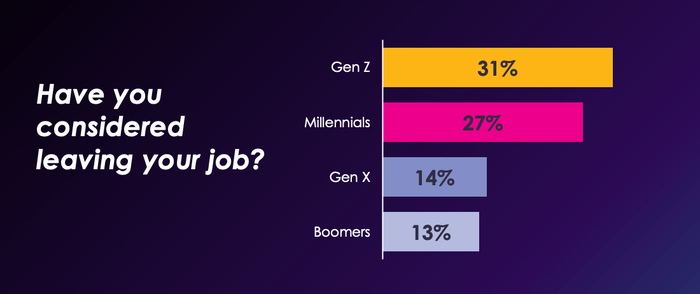How to meet employee priorities post-pandemic
The pandemic has forced many of us to rethink our priorities, resulting in what LinkedIn has suggested is a ‘great reshuffle’. In order to retain staff and optimise business recovery post-pandemic, HR leaders and companies must ensure that they support employees’ career and work-life balance goals. Here, we discuss how PayReview can help your organisation to survive and thrive amidst the ‘Great Resignation’ by giving you the HR tech required to support your recruitment and retention strategy.
What are employee priorities post-pandemic?
The labour market is a hive of activity. People are increasingly leaving their roles, and in October, vacancies hit a record high. Competition for staff is anticipated to become even fiercer in the build-up towards Christmas. The pandemic changed how employees view their work, with a Prudential study reflecting that 20% of workers have changed their careers entirely over the past year. The key drivers behind this included work-life balance, better compensation, and the desire to try something new.
A Prudential study shows that 20% of workers have changed their careers entirely over the past year.
Disruption in the workplace is at an all-time high, with many organisations still working from home. The technological transformation that this has required has accelerated digital transformation in the workplace. Flexibility is now expected, with companies that need people back in the office losing an estimated 70% of talent. The war for skills and talent has reignited, and the digital capabilities of businesses are creating the opportunity to open up the workplace to a broader talent pool who are often overlooked. Crucially, employers must take the necessary steps to engage with employees wherever they are based by actively listening to what they value from their work.
Create connections internally
HR is pivotal for employers to ensure they’re offering the right compensation strategy, both in financial terms with pay and benefits and in relation to the workplace culture. HR acts as the gatekeeper of talent - it needs to understand the key motivators that drive each individual and equip line managers with the HR tools they need to have effective conversations with employees. For these to be meaningful discussions, line managers should be clear about what they can offer employees in readiness for these conversations. Employees should be encouraged to identify what matters most to them.
The key to fuelling effective conversations is having an organisation-wide framework that ensures pay is arranged fairly internally to achieve parity of pay and externally benchmarked against the market. To achieve this organisation-wide is no small feat. There needs to be an objective pay structure to organise jobs to ensure that pay is like-for-like, and this involves securing buy-in from the whole organisation.
Align everyone to organisational purpose
Defining a company's bigger picture is vital so that all employees can feel like they’re making a difference in their roles. If the workplace maintains pay equality, so everyone is paid fairly and feels invested in their role, this bolsters recruitment and retention. There is a classic example of the NASA janitor who, when asked what he did by President John F Kennedy, replied that he was helping to put a man on the moon. This buy-in creates meaning for employees and, in turn, drives loyalty to the company they’re working for. They can see their role, and it boosts productivity and satisfaction at work.
People will stay if they feel good about their work, its values, and the leaders. Organisations are increasingly expected to cultivate a workplace that supports their careers and lives the values they espouse. Wanting to work with a diverse team, measured on the value they deliver, not the volume and expecting to be trusted to do their best work are amongst the key priorities of the future workforce, according to Harvard Business Review. Organisational purpose can galvanise the workforce, who can realise the positive outcomes their business is working towards together. This direction and alignment can help to shape the future of talent management and performance reviews directly.
Be definitive about employee experience
An EY Work Reimagined Employee Survey of 1,000 global business leaders indicates that organisations understand that most of their workers want more flexibility. Still, they need to act faster to stem the number of employees choosing to leave. By organisations not cementing their future plans, employees are defining what matters to them.
“We know that many employees are prepared to quit if they don’t get the flexibility they need and so employers who fail to move with the times do risk losing their people.
Organisations that want to flourish need to ensure that their plans are well defined and communicated, and that they balance business and employee priorities in refining these plans to help create a win-win for the business and the workforce.”
Liz Fealy, EY Global People Advisory Services Deputy Leader and Workforce Advisory Leader.
Employee Benefits reports that 69% of HR leaders admit that a lack of clear strategy is hampering their efforts to improve employee experience, as many employers are grappling with what their workplace will look like post-pandemic. In addition to overcoming ‘commitment issues around flexible working’ that the EY report discussed, employers must think about the employee journey and their everyday reality. HR leaders' changing demands and priorities mean they must continually adapt their employee experience to enable hybrid working. 62% of 200 employers surveyed stated that poor HR solutions, technology, and processes hinder employee experience. Employees need to feel that they are getting a great experience at work, and the HR strategy needs to be agile enough to respond to uncertain conditions.
How can PayReview help you bolster your employee experience?
PayReview Software
1. Supports equitable decision-making
PayReview supports line managers by providing a consistent reference framework. This supports them in having effective conversations. A substantial reward framework drives organisational efficiency and aligns rewards more directly with the company's vision. The reward for each role can be planned and mapped out using job evaluation software, enabling everyone to understand their part in achieving the company’s mission.
PayReview software organises mountains of data and ensures a consistent methodology is applied – helping with organisational design through its compensation management software. PayReview can support the creation of a reward framework, helping pay decisions to become more evidence-based, objective, and fair. The system gives managers the tools to make consistent decisions wherever they are based. The software can enable real-time decision-making and avoid duplication of effort. By side-stepping the proliferation of versions, this gives the ultimate end-user - the HR department - version control.
2. Can unlock the impact of the rest of your HR offering
Taking pay off the table as an issue focuses on the whole reward package offered to the individual. This, in turn, drives greater engagement – and an ability for HR to be given more creativity and freedom to focus on what drives the individual beyond pay.
Once employees know they’re being paid competitively, this unlocks the additional benefits that the employer offers. This will inevitably vary based on different demographics. Still, organisations seem to be grappling with how to best engage Gen Z, who are the most likely to hand in their resignation at the moment.
It is clear that Gen Z is more empowered in the workplace than older generations who are used to 9 to 5 in the office. Transformative technology that makes everyday tasks easier is a huge benefit of pay review software systems like PayReview. We’ve discussed the importance of employee experience – equipping employees with intuitive software is a huge part of meeting employee needs at work - to ease heavy workloads and make the experience positive.
3. HR can use the software to track the effectiveness of targeted pay awards
Not only is the investment in PayReview a way of streamlining the pay review process, but it is also a means of tracking the effectiveness of your reward strategy. The data can be analysed to find insights into pay practices and the outcomes. By monitoring the return on investment of an organisation that differentiates and targets pay increases, businesses can monitor the financial benefits of this approach. Targeting high performers or those with vital business skills, the investment in each individual can be adequately tailored to business requirements.
The software can support you in proactively shaping your recruitment strategy and reward strategy in particular areas. There is the opportunity to use PayReview to identify areas of recruitment and retention that pose a specific challenge, potentially highlighting areas that need more nuanced in the benchmarking data. For instance, the pay offered in one area of the business may be competitive for the sector, but there may be the need to benchmark more widely against the type of role or the geographic location to stem retention problems.
4. Free up your time
The software can remove the administrative burden of the pay review process. This helps to ease the immediate impact of the ‘Great Resignation’, which is the effect that people leaving has on the rest of the team. People resigning negatively affects the rest of the team as the burden lies on them to maintain productivity with fewer resources and less time, which is an important issue for employers to tackle. This must be done proactively to drive down retention issues and stem further resignations.
PayReview offers businesses an end-to-end solution. Our compensation software supports the entire pay and reward process to enable teams to focus on the strategic part of the pay review process. We also support the change management process required to align pay with progression and performance frameworks, taking as much of the administrative element away as possible.
Get in touch
HR tech that is intuitive and holistic in its approach can help you achieve better decision-making around rewards. PayReview can help you facilitate better data management across the whole organisation that bolsters recruitment and retention, helping you to avoid losing key people in your business and strengthen your team.
By tracking pay decisions and having a robust system in place, our software can help you embed evidence-based reward systems that help manage employees and attract talent. Get in touch today to arrange a free demo and discuss what our software can help you achieve.




